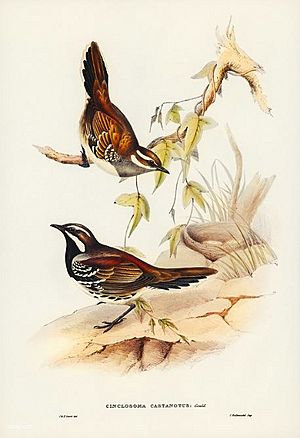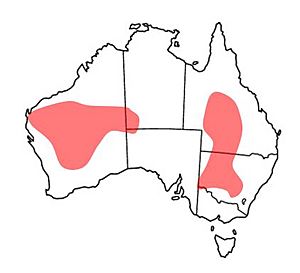Chestnut quail-thrush facts for kids
Quick facts for kids Chestnut quail-thrush |
|
|---|---|
 |
|
| Conservation status | |
| Scientific classification | |
| Genus: |
Cinclosoma
|
| Species: |
castanotum
|
The chestnut quail-thrush (Cinclosoma castanotum) is a special bird that lives only in Australia. It's part of a bird family called Cinclosomatidae. These birds like to live in dry, scrubby areas in the middle of Australia. You can find them in most Australian states, but not Tasmania. They are a bit uncommon to spot.
Contents
What Does the Chestnut Quail-Thrush Look Like?
The chestnut quail-thrush is a medium-sized bird. It lives in the lower parts of trees and bushes in dry areas.
Male vs. Female Birds
Male chestnut quail-thrushes are quite colorful. They have a bright, yellowish-chestnut chest and sides. A black stripe separates their chest from their white belly.
Female birds look a bit different. Their throat is lighter, and they don't have the black stripe. Overall, females are not as brightly colored as males. This difference between male and female appearance is called sexual dimorphism.
Sounds and Movement
These birds often gather in pairs or small family groups. They use bushes and scrub to hide. When they feel scared, they run very fast in short bursts. You can tell them apart by their high-pitched call. It sounds like a 'seep' or an insect-like 'see see see'.
Understanding Chestnut Quail-Thrush Taxonomy
The family Cinclosomatidae includes birds that mostly stay on the ground. They often squat and run along the ground while looking for food. Birds in this family, like jewel-babblers and wedgebills, also build their nests on the ground.
Who Discovered This Bird?
The chestnut quail-thrush was discovered by John Gould in 1840. He named it castanotum because of the chestnut-colored patch on its lower back. The word castanotum comes from Greek words meaning 'chestnut' and 'back'.
Different Types of Quail-Thrushes
Other quail-thrushes in the same group live in dry parts of Central Australia. Some also live in warmer, wetter areas in northern Australia and New Guinea. Famous types include the painted quail-thrush, spotted quail-thrush, and cinnamon quail-thrush.
Scientists believe that quail-thrushes in dry areas might have come from ancestors who lived in forests. This change happened as Australia's climate became drier a long time ago.
Recent Discoveries
A study in 2015 looked at the DNA of these birds. It found that chestnut quail-thrushes living east of a natural barrier (called the Eyrean Barrier) were different from those living west of it. This helped scientists understand how these bird groups are related.
Where Do Chestnut Quail-Thrushes Live?
The chestnut quail-thrush lives in a large area across the middle of Australia. This includes both semi-dry and very dry landscapes.
Specific Locations
The main type of chestnut quail-thrush is found in central Queensland. It stretches down into New South Wales. Another type, called marginatum, lives from the Northern Territory to Western Australia.
Their homes are naturally broken up by places like the Eyrean Barrier. These areas don't have the right kind of plants for the birds.
Preferred Homes
Chestnut quail-thrushes like scrub and low-lying plants. They enjoy areas with mulga-eucalyptus and acacias on stony ground. They also like grevilleas and tea trees on rocky hills.
Birds in New South Wales prefer mallee woodlands with spinifex and acacia shrubs. Those in Western Australia like woodlands with acacia shrubs and heathland. The number of birds can change depending on how often fires happen. They are most common in areas that had a fire between two and fifteen years ago.
How Chestnut Quail-Thrushes Behave and What They Eat
The chestnut quail-thrush spends most of its time on the ground. It prefers to stay under bushes to find food, build nests, and hide from enemies.
Daily Habits
These birds are active during the day. They often move by running rather than flying, even when disturbed. You can often see them in pairs or small family groups. They might be looking for food, nesting, or singing. They are very good at hiding in thick bushes when they feel threatened.
What's on the Menu?
The chestnut quail-thrush eats both plants and insects. They are omnivores. They often search through clumps of spinifex for insects like grasshoppers, beetles, and caterpillars. They also eat seeds and the fruit of different native plants.
Chestnut Quail-Thrush Reproduction
Chestnut quail-thrushes breed from July to August, just like other quail-thrushes. During this time, the males sing from early morning.
Eggs and Nests
Between August and December, depending on rainfall, females lay 2 to 3 eggs. The eggs are cream to white with brownish-black spots. They build their nests on the ground in a small dip. They use things like bark, grass, and sticks from around them.
Threats and Conservation Efforts
The chestnut quail-thrush is listed as "Least Concern" by the IUCN. This means they are not in immediate danger of disappearing.
Where They Are Declining
However, their numbers have dropped in some parts of Western Australia. This includes areas like Kellerberrin and Dryandra. Their numbers also seem to be falling in parts of New South Wales.
Main Dangers
These birds face several threats:
- Habitat Loss: Land clearing destroys their homes and breaks up their living areas.
- Human Activity: Nearby human activities can harm their habitat.
- Predators: Animals like cats and foxes hunt them.
- Fires: The wrong kind of fire patterns can quickly change their landscape.
- Climate Change: Future threats from changes in climate are also a concern.
Helping the Birds
To help protect them, people have suggested some ideas:
- Reducing the number of farm animals in their habitat.
- Keeping remaining grasslands and shrublands safe.
- Controlling invasive predators like cats and foxes.
- Creating and following a good plan for managing fires.
See also
 In Spanish: Zordala castaña para niños
In Spanish: Zordala castaña para niños




